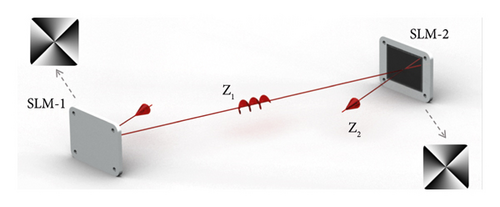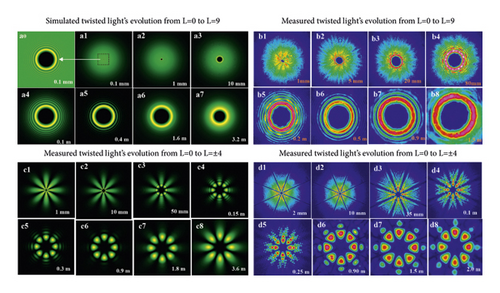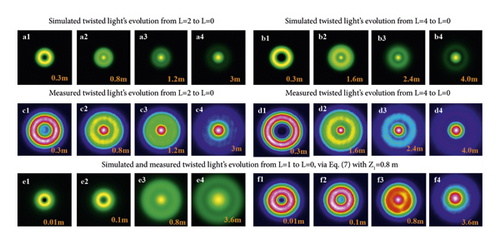Diffractive Theory Study of Twisted Light’s Evolution during Phase-Only OAM Manipulations
Abstract
Twisted light, or orbital angular momentum (OAM) carrying beams or photons, is a pillar of structured photonics, a booming subfield of modern optics. The generation and transformation of twisted light, which lie with coupling topological charges into target light’s wavefunctions, are usually performed by phase-only OAM manipulations. The practical twisted lights, however, obtained by this method are actually noneigen modes of free space, leading to an evolution through the diffractive propagation. Here, we present a general theoretical frame for accurately describing this evolution. Based on the theory, the whole diffractive propagation history in a typical OAM-manipulation loop, converting Gaussian light into a twisted one and then reconverting back, is demonstrated via a set of exact analytical solutions. These results provide a powerful tool for analyzing the transverse profiles of twisted light through the diffractive evolution, as a guideline for studying the science of structured light, which would provide guidelines for research studies in nonlinear optics and high-dimensional quantum information technology based on OAM-degree of freedom.
1. Introduction
Structured photonics, i.e., generation and application of light fields with custom transverse phase and polarization profiles, has gained so rapid progress over the past decade that it has gradually become an important subfield of modern optics [1]. In this new subject, orbital angular momentum (OAM) carrying beams or photons received the most attention from the optical community, ranging from high-capacity optical communications [2, 3], light trapping and manipulation [4], high-precise optical metrology [5–7], nonlinear optics [8–12], to high-dimension quantum information [13–18]. All these research studies originate from the factor that twisted light (or vortex beam) carries a spiral phase term or to say carries orbital angular momentum each photon [19], leading to two special properties: unbounded dimension of OAM degree-of-freedom and tailorable light-matter interface owning to its unique phase and intensity distributions. In physics layer, the subfield (OAM photonics) comes down to manipulating and controlling the transverse wavefunctions of the twisted light, or rather, coupling a helical phase (or topological charge) into the target light’s wavefunction. We note that these helical phase transition processes not only occur in linear interaction domain but also broadly refer to nonlinear interactions among coherent fields or photons [8–18].
Laguerre–Gaussian (LG) modes, as eigenstates of OAM degree-of-freedom and standard solutions of free-space paraxial wave equation (PWE), hence, are a natural choice for describing twisted light elegantly. For practical twisted light people used, usually converted from Gaussian light via phase-only OAM manipulation, however, is not a natural solution of the PWE but a hypergeometric Gaussian mode which can be expressed as a linear superposition of different LG modes with the same topological charge at the waist plane [20]. We note that noneigen solution of free-space PWE means that its transverse wavefunction will not be constant in LG space upon propagation. In the general research studies, most attention is mainly focused on the initial and final states of twisted light’s wavefunctions, yet the wavefunctions’ evolution during propagation is also pretty important. To date, the practical twisted light and its evolution have been broadly studied via PWE’s solutions [21–25]. However, in many scenarios, such as shaping 3D polarization structures [26–28], tailoring nonlinear optical interactions [29–31], and studying fundamental physics [32], to master accurate evolution history of the wavefunctions during multiple/various manipulations is prerequisite. To address this issue, here, based on diffractive optical theory, we present a universal theoretical frame for describing the accurate dynamical evolution of the twisted light’s wavefunction. The theoretical and experimental results indicate that the theoretical model can predict the whole evolution of the wavefunction during cascading phase-only OAM manipulations accurately. This framework provides a feasible way to analyse custom light fields’ specific parameters with high accuracy during the whole evolution, such as polarization distributions and wavevector’s axial components [26, 27, 32, 33].
2. Results and Discussion

Equation (4) represents a hypergeometric Gaussian mode, where F(α, β, z) is the hypergeometric function, and . It can be noted that the helical phase term , referring to OAM conservation, is invariant throughout the diffracting evolution process. Figure 2(a) shows the theoretical transverse profiles of the twisted light, simulated via equation (4), upon diffraction. We can see the vortex inlayed at the center of the donut gradually enlarges upon propagation and, especially, rapidly grows up during the early stage of evolution. More notably, although the topological charge is constant, the orthogonal radial structure changes through the propagation history. It is complex (multirings) and evolves rapidly at the beginning and, finally, approaches a simplex structure (single-ring) or to say approximates to a certain LG mode in the far field. Figure 2(b) shows the corresponding experimental results, which pretty much agree with the simulation. Besides, an analogue result for a superposition state is shown in Figures 2(c) and 2(d), the simulation and experimental results agree well with each other, again, proving the framework’s superiority.


Figures 3(c) and 3(d) show the corresponding experimental results, which agree well with the theoretical prediction once again. The slight distortion of the experimental beam profiles to the theoretical beam profile can be caused by beam misalignment and low surface quality of the spatial light modulator. In experiment, Z1 was set as 40 cm. The results shown here raise a key question concerned by most researchers dedicating in OAM photonics: how to reduce or avoid the residual outer rings left over by reconverting processes (meaning a low conversion efficiency and energy loss) and how to accomplish the processes more quickly? Here, the key point is although the topological charge changes instantaneously in mode conversions, it has left an indelible imprint on the “carrier light” during the first diffracting propagation. To comprehend this point, one can find the parameter in terms that express as a function of propagation distance in equation (4) or standard LG modes in Gouy phase. In some degree, the question raised previously is equivalent to ask: can light or photons diffracted from a slit completely pass through another slit? Based on the time reversal invariance of wave dynamics, a straightforward proposal for overcoming this point is to erase any imprints recorded in the propagation history, namely back to the initial condition shown in equation (1), before the reconversion. A feasible method for achieving the proposal is time-reversal or phase-conjugation operation, and more specific details are out of the scope of this paper and are covered in a separate article.
3. Conclusion
In summary, we have presented a universal theoretical framework for describing the practical twisted light during phase-only OAM manipulation and control. The transverse wavefunction, derived from this universal diffractive optical model, can accurately predict the evolution of the twisted light through a typical OAM manipulation loop, including generation, diffracting propagation, and the reverse transformation. Our results provide a helpful and powerful theoretical tool for researching and applying structured light. Moreover, by changing the initial conditions (input light) and transformation conditions (optical system parameters) in equation (2), one can easily extend this flexible framework to describe other experimental configurations, for instance, predicting OAM-multiplexed beam properties since emit from the optical system.
Conflicts of Interest
The authors declare that they have no conflicts of interest.
Acknowledgments
This work was supported by the National Key Research and Development Program of China (2022YFB3607700 and 2022YFB3900027), National Natural Science Foundation of China (NSFC) (11934013 and 92065101), Anhui Initiative in Quantum Information Technologies (AHY020200), Innovation Program for Quantum Science and Technology (2021ZD0301100), and the Space Debris Research Project of China (no. KJSP2020020202).
Open Research
Data Availability
The data used to support the findings of this study are available from the corresponding author upon reasonable request.




